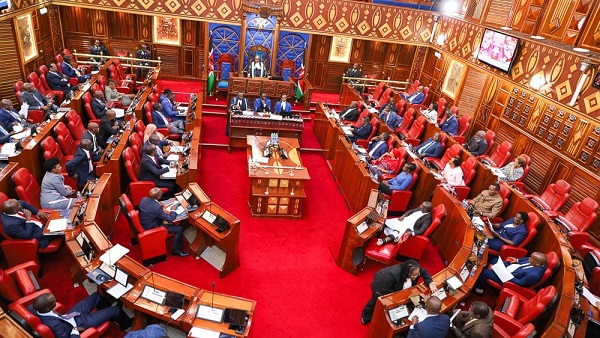Serjeant at Arms
I. Introduction
The Serjeant-at-Arms is a Parliamentary officer responsible for enforcing the Standing Orders, Speaker’s Rules and Orders to ensure order and decorum. The Serjeant-at-Arms also performs ceremonial duties including carrying the mace to and from the House during ordinary and special sittings of the House. The Serjeant-at-Arms also keeps order during meetings, and, if necessary, forcibly removes any members or guests who are overly rowdy or disruptive. A Serjeant-at-arms may be a retired soldier, police officer, or other official with experience in security
II.Origin of Serjeant-at-Arms
Originally Serjeant-at-Arms were members of the King's bodyguard. The title serjeant-at-arms seems to have developed during the Crusades in the twelfth century. Although armed guards were common in armies, Serjeant-at-arms was seen as different, as they were middle class. They carried battle maces to use as weapons. Apart from duties as bodyguards, they also had some power to act for the King, including arresting and imprisoning people,
The concept of serjeants-at-arms spread across England. Cities and boroughs employed serjeants to carry out administrative and bailiff duties. These officials were not as high ranking as serjeants appointed by the King, but they could also arrest and imprison people.
The House of Commons first appointed a Serjeant-at-Arms in 1415. There are various theories why at the time the Speaker was often in a difficult and dangerous position. He tried to meet the demands of the House, which he was there to serve, and also the conflicting interests of the King. Therefore, one of the Serjeant's most important tasks was to protect the Speaker from his enemies in the House.
However, the Serjeant had another important role. He carried out the House's instructions and protected members' rights. Those rights allowed members to speak freely in debates, and carry out their duties without interference. For example, members could not be arrested and imprisoned for a debt.The House needed to enforce those rights, particularly as members were increasingly challenged by officials outside Parliament. The Serjeant could arrest and imprison people. He brought prisoners to the entrance of the Chamber (known as the bar of the House) for questioning.
Over the years the Serjeant also became an essential figure on ceremonial occasions, and the House's official messenger. Serjeants took on additional responsibilities including door-keeping, housekeeping and maintaining the Parliament building. These duties were the core responsibilities of the Legislative Assembly's.
The title of Sergeant-at-Arms appears during the Crusades, when Philip II of France formed a special corps to guard him in the Holy Land in 1192. They always appeared in public encased in armour, and carried a decorated battle-mace as a weapon and as a badge of their office.
It is almost certain that the notion of 'Sergeant' came to England from France with the Normans. The maintenance of law and order, and the execution of warrants were the earliest functions of the Sergeant-at-Arms. Because he attended the Speaker, he was involved in all ceremonial functions connected with that office. He was also charged with keeping the doors and making sure that the Commons was clean. Marsden writes that from very early in his history, the Sergeant-at-Arms was the Commons' Usher, Keeper of the Doors, and Housekeeper. As the public became more aware of the activities of Parliament and began to attend sittings, someone was needed to maintain order
III. Evolution of the Department in Kenya
The history of Serjeant at Arms Department in Kenya is an example of steady progress from colonial autocracy to a true modern democracy. As a department with a colonial past, the transition process has also evolved through two distinct phases-the pre-independence era, and the post-independence roles of SAA.
The office of SAA has an equally humble beginning from the colonial days and its officers, the Clerks and the Hansard reporters were once regarded as the only officers of the House until very recently. This officer is responsible for the security of the House, an increasingly heavy burden in the current context of terrorism, and for physically enforcing the orders of the Speaker, for instance, in ensuring that suspended Members are removed from the House if they do not leave when ordered to do so by the Speaker
- For a very long time even after independence, there was no significant security threat facing Parliament as an institution so the Department remained lean in form and mean in ostentation.
- The Department was only concerned with ceremonial duties, custodial responsibilities and housekeeping functions, e.g. cleaning, sprucing, manicuring and guarding the Buildings, flower gardens, lawns, etc.
- Staffing at the upper echelons was done by the President appointing the Chief Serjeant-at-Arms and other Senior Serjeant-at-Arms attached form intelligence services while the rest of the staff were recruited through the PSC or transfers by the Directorate of Personnel Management (DPM) in OP.
- Debates on the Floor became very robust, vibrant and explosive at times thus requiring more staff to process people coming to the public gallery and ensuring order prevailed there.
- The need for more officers both in terms of numbers and variety of skills required to discharge all these duties significantly increased.
- The heightened public prestige of the Legislature had serious consequences on its own security that nobody seemed to have properly or accurately understood, least of all anticipated.
- The 1998 bomb-blast in Nairobi, the 9/11 of 2001 in the US, the attacks on other Parliaments and several other acts of terrorism across the world demanded a review of security at Parliament Buildings.
- In 2003, all the Intelligence Officers were removed and their place taken over by newly recruited officers from the military and an Integrated Security Surveillance System installed with very scanty preparedness.
- The solution is to recruit the Sergeants-at-Arms from senior ranks in security agencies and administration with commensurate skills and maturity to be trusted with information on intelligence.
- In 2014 more senior officers were recruited to facilitate in the implementation of the Constitution of Kenya 2010 by developing new policies that will enhance service delivery in the new Senate.
SAA evolution in the Senate
o Masor M.G. Eliot – 1960-1964
o Asst.SAA Mr. S.G. Kibuthu-1965-1967
o Major (Rtd) S. Obange -2012- 2014
o Major (Rtd) S. Sorobit -2014 to date
IV. SERJEANT -AT-ARMS SERVICES
The Serjeant-at-Arms (SAA) is one of the earliest known offices of the Commonwealth Parliamentary system. The origin of the office can be traced to the British Monarchy where the Serjeant-at-Arms performed all administrative work. However, the current roles of the SAAs have undergone massive transformation and they have been assigned specific roles in modern parliamentary work.
The key functional areas of the department include:
a. Chamber Services
The SAA provides services to the Speaker and the Clerk and plays an integral role in maintaining order and decorum in the Chamber. The SAA has authority to remove disorderly Senators from the House on the instructions of the Speaker. The same rules and regulations apply to the media and the public from the galleries or within the precincts. In addition, the SAA ensure that all Senators are registered in the Biometrics system and are logged in when entering the Chamber. In addition SAA ensures that all Senators are registered manually during plenary sessions as a back-up measure for purposes of maintaining the record of attendance for payment of sitting allowance.
b. Estate Management
The department maintains the heritage of Parliament Buildings, objects and documents for the benefit of future generations. The department is further charged with office furnishing and allocation of office accommodation to Senators and Staff.
c. House Keeping Services
The SAA as the house keeper of Parliament has responsibility for cleanliness of Parliamentary offices and tending the gardens of the entire estate. The department undertakes contract management services especially for cleaning of common areas, garbage collection and fumigation for the entire estate of Parliament.
d. Ceremonial Duties
The ceremonial duties of the SAA involve supporting members of Parliament in events such as, State opening of Parliament, Visiting Head of State Address, Annual State of the Nation Address by the President, and funerals for sitting Senators. This responsibility extends to State functions during the laying of wreath at the Mausoleum of the First President, the Late H. E Mzee Jomo Kenyatta.
e. Event Management and Protocol Services
The SAA plans, prepares, and coordinates official functions and events held in Parliament. This includes, but is not limited to the State of the Nation Address by the President, the National Prayer Breakfast, major conferences and other official engagements by the leadership and Senators. The participation of Senators in public holidays celebrations is also coordinated by Serjeant-at-Arms. They identify, screen and usher Senators during such occasions.
f. Committee Support Services
The SAA support the Directorate of Committee Services through service of summons or invitations to appear before Committees, allocation of committee rooms, provision of safety and security to Senators during committee visits, summoning of witnesses, crowd control during visits, and compiling of reports on experiences and challenges faced during such visits.
The staffers assigned to committees as part of the secretariat, organize allocation of venues for committee sittings across the parliamentary square according to the committee schedule of each succeeding week, and coordinate security whenever there is public hearing.
The SAA conduct risk assessment prior and during the committee field visits, which helps in the design of suitable mitigating measures to safeguard the Senators and Staff.
g. Custody of the Mace
The Mace is the symbol of Parliamentary authority and it is the duty of the SAA to protect, secure and maintain it. The SAA carry the Mace during the speaker’s procession into the Chamber and during the rise of the Senate. The SAA coordinates the transition of the business of the Senate from Plenary to Committee of the Whole by lowering the Mace from the table to the lower bracket or hoisting it into place on resumption of Plenary.
h. Safety and Security Mandate
Parliament security is carried out in two layers, that is, the outer and inner layer. The Serjeant-at-Arms is in charge of the inner layer of security. The SAA ensures safety and security of Senators and staff within the allocated office accommodation. SAA are the primary custodians of all offensive weapons brought legally into the precincts and as specified in the Standing Orders. In providing access control management services, they process temporary entry passes to visitors and journalists to access the gallery.
The department coordinates with the relevant national security agency for the provision of a bodyguard that meets the needs of the individual Senator.The SAA provides each Senator with photo identification that captures the personal details and bears the particulars of the County or area of representation as the official identification document for a member of the Senate.
i. Legislative Outreach
The SAA plays an important role in delivering the Senate’s wide agenda of connecting the public with Parliament through coordination of visits by dignitaries from other Countries, County Assemblies, and institutions of higher learning and schools. Parliament continues to attract thousands of visitors each year. Although the majority of these visitors are school children, other categories include: dignitaries, guests hosted by committees, delegates to conferences and seminars hosted by Parliament, special interest groups and the public.
Another aspect of visitor services is providing reception duties in all Parliament Buildings and processing of persons for security purposes while accessing Parliament and assisting witnesses appearing before Senate Committees.




















